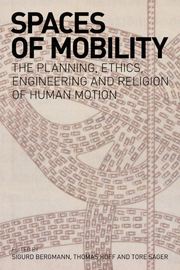Book contents
- Frontmatter
- Contents
- List of illustrations and tables
- Contributors
- Preface
- Acknowledgements
- 1 The beauty of speed or the cross of mobility? Introductory reflections on the aesth/ethics of space, justice and motion
- Part I
- Part II
- Part III
- 8 Mobility: discourses from the non-Western immigrant groups in Norway
- 9 Inclusive mobility: participation, physical barriers and the concept of universal design
- 10 Freedom as mobility: implications of the distinction between actual and potential travelling
- Index
9 - Inclusive mobility: participation, physical barriers and the concept of universal design
from Part III
- Frontmatter
- Contents
- List of illustrations and tables
- Contributors
- Preface
- Acknowledgements
- 1 The beauty of speed or the cross of mobility? Introductory reflections on the aesth/ethics of space, justice and motion
- Part I
- Part II
- Part III
- 8 Mobility: discourses from the non-Western immigrant groups in Norway
- 9 Inclusive mobility: participation, physical barriers and the concept of universal design
- 10 Freedom as mobility: implications of the distinction between actual and potential travelling
- Index
Summary
Perspectives on mobility, accessibility and participation
Norwegian politicians have stated their support for an inclusive society with citizens who are fully able to participate and afforded equal opportunities. Although mobility is a political priority, mobility on its own is perceived as a means rather than a goal, since mobility restrictions limit accessibility in almost all major areas of life: physical activity, social life, education, work, cultural life and participatory democracy. Barriers people experience indicate that there is a misfit between the individual and the city spaces and pulsating arterial transport links that bring life to the city. We have all had the experience of being children and finding that steps were too high to climb or that public transport was too difficult to understand. At any given moment, three out of ten people report having substantial difficulties using public transport. Furthermore, throughout their lifetimes, seven out of ten will experience mobility difficulties due to illness or injury.
One of the aspects of exploring the technical space of mobility is exploring how and why mobility provides different opportunities to different people. An inclusive society is about providing citizens with equal opportunities to participate in activities that are important to them. Everyone does not need to travel the same amount, or in the same manner, but the restrictions they encounter in attempting to travel should be similar, and independent of age, gender, ethnicity, experience, skills and abilities.
- Type
- Chapter
- Information
- Spaces of MobilityThe Planning, Ethics, Engineering and Religion of Human Motion, pp. 205 - 242Publisher: Acumen PublishingPrint publication year: 2008



